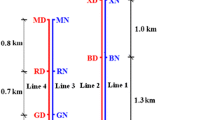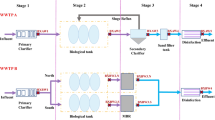Abstract
Bacterial community in the drinking water distribution system (DWDS) was regulated by multiple environmental factors, many of which varied as a function of water age. In this study, four water samples with different water ages, including finished water (FW, 0 d) and tap water (TW) [TW1 (1 d), TW2(2 d) and TW3(3 d)], were collected along with the mains of a practical DWDS, and the bacterial community was investigated by high-throughput sequencing technique. Results indicated that the residual chlorine declined with the increase of water age, accompanied by the increase of dissolved organic matter, total bacteria counts and bacterial diversity (Shannon). For bacterial community composition, although Proteobacteria phylum (84.12%-97.6%) and Alphaproteobacteria class (67.42%-93.09%) kept dominate, an evident regular was observed at the order level. In detail, the relative abundance of most of other residual orders increased with different degrees from the start to the end of the DWDS, while a downward trend was uniquely observed in terms of Rhizobiales, who was inferred to be chlorine-resistant and be helpful for inhibiting pipes corrosion. Moreover, some OTUs were found to be closely related with species possessing pathogenicity and chlorine-resistant ability, so it was recommended that the use of agents other than chlorine or agents that can act synergically with chlorine should be developed for drinking water disinfection. This paper revealed bacterial community variations along the mains of the DWDS and the result was helpful for understanding bacterial ecology in the DWDS.

Similar content being viewed by others
References
Chu W, Li X, Bond T, Gao N, Yin D. The formation of haloacetamides and other disinfection by-products from nonnitrogenous low-molecular weight organic acids during chloramination. Chemical Engineering Journal, 2016, 285: 164–171
El-Chakhtoura J, Prest E, Saikaly P, van Loosdrecht M, Hammes F, Vrouwenvelder H. Dynamics of bacterial communities before and after distribution in a full-scale drinking water network. Water Research, 2015, 74: 180–190
Douterelo I, Sharpe R L, Boxall J B. Influence of hydraulic regimes on bacterial community structure and composition in an experimental drinking water distribution system. Water Research, 2013, 47 (2): 503–516
Chu C, Lu C. Effects of oxalic acid on the regrowth of heterotrophic bacteria in the distributed drinking water. Chemosphere, 2004, 57 (7): 531–539
Ndiongue S, Huck P M, Slawson R M. Effects of temperature and biodegradable organic matter on control of biofilms by free chlorine in a model drinking water distribution system. Water Research, 2005, 39(6): 953–964
Andra S S, Makris K C, Botsaris G, Charisiadis P, Kalyvas H, Costa C N. Evidence of arsenic release promoted by disinfection by-products within drinking-water distribution systems. Science of the Total Environment, 2014, 472: 1145–1151
Lu J, Struewing I, Vereen E, Kirby A E, Levy K, Moe C, Ashbolt N. Molecular Detection of Legionella spp. and their associations with Mycobacterium spp., Pseudomonas aeruginosa and amoeba hosts in a drinking water distribution system. Journal of Applied Microbiology, 2016, 120(2): 509–521
Thomas J M, Ashbolt N J. Do free-living amoebae in treated drinking water systems present an emerging health risk? Environmental Science & Technology, 2011, 45(3): 860–869
Falkinham J O 3rd. Surrounded by mycobacteria: nontuberculous mycobacteria in the human environment. Journal of Applied Microbiology, 2009, 107(2): 356–367
Wang H, Edwards M, Falkinham J O 3rd, Pruden A. Molecular survey of the occurrence of Legionella spp., Mycobacterium spp., Pseudomonas aeruginosa, and amoeba hosts in two chloraminated drinking water distribution systems. Applied and Environmental Microbiology, 2012, 78(17): 6285–6294
von Baum H, Welte T, Marre R, Suttorp N, Ewig S. Communityacquired pneumonia through Enterobacteriaceae and Pseudomonas aeruginosa: Diagnosis, incidence and predictors. European Respiratory Journal, 2010, 35(3): 598–605
Henne K, Kahlisch L, Höfle M G, Brettar I. Seasonal dynamics of bacterial community structure and composition in cold and hot drinking water derived from surface water reservoirs. Water Research, 2013, 47(15): 5614–5630
Mi Z, Dai Y, Xie S, Chen C, Zhang X. Impact of disinfection on drinking water biofilm bacterial community. Journal of Environmental Sciences (China), 2015, 37: 200–205
Jang H J, Choi Y J, Ka J O. Effects of diverse water pipe materials on bacterial communities and water quality in the annular reactor. Journal of Microbiology and Biotechnology, 2011, 21(2): 115–123
Manuel C M, Nunes O C, Melo L F. Dynamics of drinking water biofilm in flow/non-flow conditions. Water Research, 2007, 41(3): 551–562
Li M, Liu Z, Chen Y, Hai Y. Characteristics of iron corrosion scales and water quality variations in drinking water distribution systems of different pipe materials. Water Research, 2016, 106: 593–603
Chao Y, Ma L, Yang Y, Ju F, Zhang X X, Wu W M, Zhang T. Metagenomic analysis reveals significant changes of microbial compositions and protective functions during drinking water treatment. Scientific Reports, 2013, 3(1): 3550
Prest E I, Hammes F, Kötzsch S, van Loosdrecht M C, Vrouwenvelder J S. Monitoring microbiological changes in drinking water systems using a fast and reproducible flow cytometric method. Water Research, 2013, 47(19): 7131–7142
Amato K R, Yeoman C J, Kent A, Righini N, Carbonero F, Estrada A, Gaskins H R, Stumpf R M, Yildirim S, Torralba M, Gillis M, Wilson B A, Nelson K E, White B A, Leigh S R. Habitat degradation impacts black howler monkey (Alouatta pigra) gastrointestinal microbiomes. ISME Journal, 2013, 7(7): 1344–1353
Delafont V, Bouchon D, Héchard Y, Moulin L. Environmental factors shaping cultured free-living amoebae and their associated bacterial community within drinking water network. Water Research, 2016, 100: 382–392
Mathieu L, Bouteleux C, Fass S, Angel E, Block J C. Reversible shift in the α-, β- and g-proteobacteria populations of drinking water biofilms during discontinuous chlorination. Water Research, 2009, 43(14): 3375–3386
Jeong C H, Postigo C, Richardson S D, Simmons J E, Kimura S Y, Mariñas B J, Barcelo D, Liang P, Wagner E D, Plewa M J. Occurrence and comparative toxicity of Haloacetaldehyde disinfection byproducts in drinking water. Environmental Science & Technology, 2015, 49(23): 13749–13759
Petterson S R, Stenström T A. Quantification of pathogen inactivation efficacy by free chlorine disinfection of drinking water for QMRA. Journal of Water and Health, 2015, 13(3): 625–644
Dietrich J P, Loge F J, Ginn T R, Başağaoğlu H. Inactivation of particle-associated microorganisms in wastewater disinfection: Modeling of ozone and chlorine reactive diffusive transport in polydispersed suspensions. Water Research, 2007, 41(10): 2189–2201
Lynch F, Tomlinson S, Palombo E A, Harding I H. An epifluorescence-based evaluation of the effects of short-term particle association on the chlorination of surface water bacteria. Water Research, 2014, 63: 199–208
Wang H, Hu C, Zhang L, Li X, Zhang Y, Yang M. Effects of microbial redox cycling of iron on cast iron pipe corrosion in drinking water distribution systems. Water Research, 2014, 65: 362–370
Zarasvand K A, Rai V R. Microorganisms: Induction and inhibition of corrosion in metals. International Biodeterioration & Biodegradation, 2014, 87: 66–74
Kankaala P, Peura S, Nykänen H, Sonninen E, Taipale S, Tiirola M, Jones R I. Impacts of added dissolved organic carbon on boreal freshwater pelagic metabolism and food webs in mesocosm experiments. Fundamental and Applied Limnology, 2010, 177(3): 161–176
Lin W, Yu Z, Chen X, Liu R, Zhang H. Molecular characterization of natural biofilms from household taps with different materials: PVC, stainless steel, and cast iron in drinking water distribution system. Applied Microbiology and Biotechnology, 2013, 97(18): 8393–8401
Gomez-Alvarez V, Revetta R P, Santo Domingo J W. Metagenomic analyses of drinking water receiving different disinfection treatments. Applied and Environmental Microbiology, 2012, 78(17): 6095–6102
World Health Organization. Guidelines for Drinking-Water Quality. 4th ed. Geneva: World Health Organization. 2011, xxiii, 541 p
Ryan M P, Adley C C. Sphingomonas paucimobilis: A persistent Gram-negative nosocomial infectious organism. Journal of Hospital Infection, 2010, 75(3): 153–157
Lee E S, Yoon T H, Lee M Y, Han S H, Ka J O. Inactivation of environmental mycobacteria by free chlorine and UV. Water Research, 2010, 44(5): 1329–1334
Zhang M, Liu W, Nie X, Li C, Gu J, Zhang C. Molecular analysis of bacterial communities in biofilms of a drinking water clearwell. Microbes and Environments, 2012, 27(4): 443–448
Sun W. Study on the Biological Safety of Drinking Water Following UV Disinfection. Dissertation for the Doctoral Degree. Beijing: Tsinghua University, 2010
Acknowledgements
This work was supported by China’s National Critical Project for Science and Technology on Water Pollution Prevention and Control (Nos. 2017ZX07201-001 & 2017ZX07403-002), Research on Security Insurance for Directly Drinking Water Projecct of Chuanli (No. CDCL201501).
Author information
Authors and Affiliations
Corresponding author
Electronic supplementary material
Rights and permissions
About this article
Cite this article
Wang, F., Li, W., Li, Y. et al. Molecular analysis of bacterial community in the tap water with different water ages of a drinking water distribution system. Front. Environ. Sci. Eng. 12, 6 (2018). https://doi.org/10.1007/s11783-018-1020-4
Received:
Revised:
Accepted:
Published:
DOI: https://doi.org/10.1007/s11783-018-1020-4




